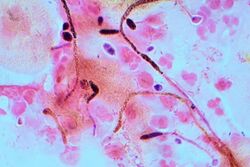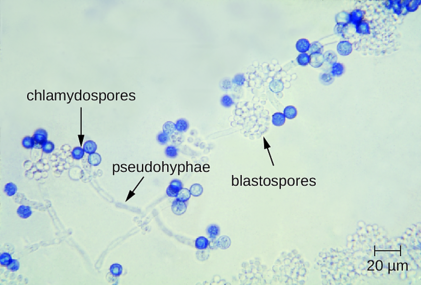Biology:Chlamydospore

A chlamydospore is the thick-walled large resting spore of several kinds of fungi, including Ascomycota such as Candida,[1] Basidiomycota such as Panus,[2] and various Mortierellales species.[3] It is the life-stage which survives in unfavourable conditions, such as dry or hot seasons. Fusarium oxysporum which causes the plant disease Fusarium wilt is one which forms chlamydospores in response to stresses like nutrient depletion. Mycelia of the pathogen can survive in this manner and germinate in favorable conditions.
Chlamydospores are usually dark-coloured, spherical, and have a smooth (non-ornamented) surface. They are multicellular, with cells connected by pores in the septae between cells.
Chlamydospores are a result of asexual reproduction (in which case they are conidia called chlamydoconidia) or sexual reproduction (rare). Teliospores are special kind of chlamydospores formed by rusts and smuts.
Chlamydospores of the yeast Candida albicans
See also
References
- ↑ Staib, P; Morschhäuser, J (2007). "Chlamydospore formation in Candida albicans and Candida dubliniensis--an enigmatic developmental programme". Mycoses 50 (1): 1–12. doi:10.1111/j.1439-0507.2006.01308.x. PMID 17302741.
- ↑ Dennis, R. L. (1969). "Fossil mycelium with clamp connections from the middle pennsylvanian". Science 163 (3868): 670–1. doi:10.1126/science.163.3868.670. PMID 17742734. Bibcode: 1969Sci...163..670D.
- ↑ Wagner, L.; Stielow, B.; Hoffmann, K.; Petkovits, T.; Papp, T.; V, C. (2013). "A comprehensive molecular phylogeny of the Mortierellales (Mortierellomycotina) based on nuclear ribosomal DNA". Persoonia 30 (1): 77–93. doi:10.3767/003158513x666268. PMID 24027348.
External links
- The chlamydospores of Candida albicans[1], [2]
- Chlamydospore development [3][yes|permanent dead link|dead link}}]
 |



